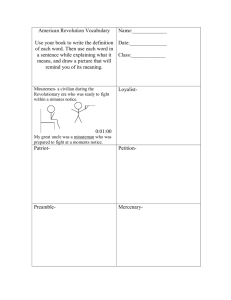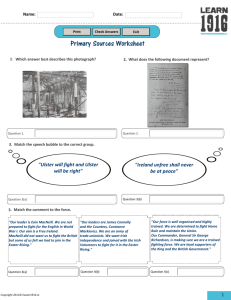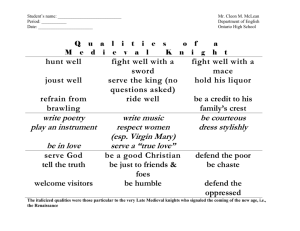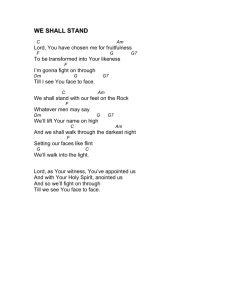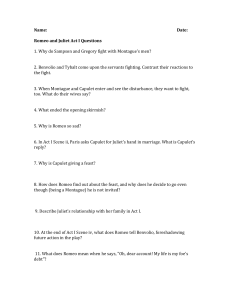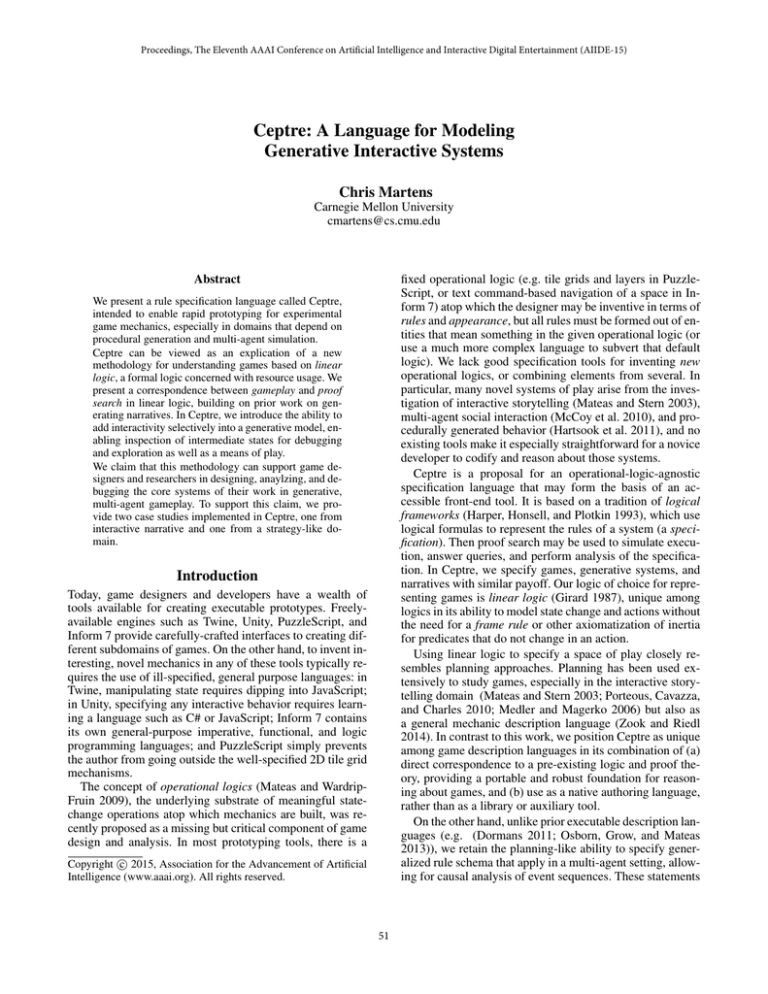
Proceedings, The Eleventh AAAI Conference on Artificial Intelligence and Interactive Digital Entertainment (AIIDE-15)
Ceptre: A Language for Modeling
Generative Interactive Systems
Chris Martens
Carnegie Mellon University
cmartens@cs.cmu.edu
Abstract
fixed operational logic (e.g. tile grids and layers in PuzzleScript, or text command-based navigation of a space in Inform 7) atop which the designer may be inventive in terms of
rules and appearance, but all rules must be formed out of entities that mean something in the given operational logic (or
use a much more complex language to subvert that default
logic). We lack good specification tools for inventing new
operational logics, or combining elements from several. In
particular, many novel systems of play arise from the investigation of interactive storytelling (Mateas and Stern 2003),
multi-agent social interaction (McCoy et al. 2010), and procedurally generated behavior (Hartsook et al. 2011), and no
existing tools make it especially straightforward for a novice
developer to codify and reason about those systems.
Ceptre is a proposal for an operational-logic-agnostic
specification language that may form the basis of an accessible front-end tool. It is based on a tradition of logical
frameworks (Harper, Honsell, and Plotkin 1993), which use
logical formulas to represent the rules of a system (a specification). Then proof search may be used to simulate execution, answer queries, and perform analysis of the specification. In Ceptre, we specify games, generative systems, and
narratives with similar payoff. Our logic of choice for representing games is linear logic (Girard 1987), unique among
logics in its ability to model state change and actions without
the need for a frame rule or other axiomatization of inertia
for predicates that do not change in an action.
Using linear logic to specify a space of play closely resembles planning approaches. Planning has been used extensively to study games, especially in the interactive storytelling domain (Mateas and Stern 2003; Porteous, Cavazza,
and Charles 2010; Medler and Magerko 2006) but also as
a general mechanic description language (Zook and Riedl
2014). In contrast to this work, we position Ceptre as unique
among game description languages in its combination of (a)
direct correspondence to a pre-existing logic and proof theory, providing a portable and robust foundation for reasoning about games, and (b) use as a native authoring language,
rather than as a library or auxiliary tool.
On the other hand, unlike prior executable description languages (e.g. (Dormans 2011; Osborn, Grow, and Mateas
2013)), we retain the planning-like ability to specify generalized rule schema that apply in a multi-agent setting, allowing for causal analysis of event sequences. These statements
We present a rule specification language called Ceptre,
intended to enable rapid prototyping for experimental
game mechanics, especially in domains that depend on
procedural generation and multi-agent simulation.
Ceptre can be viewed as an explication of a new
methodology for understanding games based on linear
logic, a formal logic concerned with resource usage. We
present a correspondence between gameplay and proof
search in linear logic, building on prior work on generating narratives. In Ceptre, we introduce the ability to
add interactivity selectively into a generative model, enabling inspection of intermediate states for debugging
and exploration as well as a means of play.
We claim that this methodology can support game designers and researchers in designing, anaylzing, and debugging the core systems of their work in generative,
multi-agent gameplay. To support this claim, we provide two case studies implemented in Ceptre, one from
interactive narrative and one from a strategy-like domain.
Introduction
Today, game designers and developers have a wealth of
tools available for creating executable prototypes. Freelyavailable engines such as Twine, Unity, PuzzleScript, and
Inform 7 provide carefully-crafted interfaces to creating different subdomains of games. On the other hand, to invent interesting, novel mechanics in any of these tools typically requires the use of ill-specified, general purpose languages: in
Twine, manipulating state requires dipping into JavaScript;
in Unity, specifying any interactive behavior requires learning a language such as C# or JavaScript; Inform 7 contains
its own general-purpose imperative, functional, and logic
programming languages; and PuzzleScript simply prevents
the author from going outside the well-specified 2D tile grid
mechanisms.
The concept of operational logics (Mateas and WardripFruin 2009), the underlying substrate of meaningful statechange operations atop which mechanics are built, was recently proposed as a missing but critical component of game
design and analysis. In most prototyping tools, there is a
c 2015, Association for the Advancement of Artificial
Copyright Intelligence (www.aaai.org). All rights reserved.
51
can be made more meaningful after an introduction to the
language, so we postpone further discussion of related work
to a later section. In the remainder of the paper, we illustrate
the semantics and utility of Ceptre through two case studies:
a generative story world and a skeletal dungeon-crawling adventure game.
at character location : pred.
likes character character : pred.
anger character character : pred.
has character object : pred.
depressed character : pred.
dead character : pred.
Next, we specify how the story state may evolve via rules
of the form rulename : A -o B, where A and B each have
the form p1 *. . .*pn , where the pi s are predicates drawn from
the above set. Predicates may contain variables that range
over the term type corresponding to that predicate index. The
meaning of A -o B, to a first approximation, is that whenever the predicates in A are present, they may be replaced
with B. One example of a rule is:
Specifying Mechanics in Ceptre
Ceptre affords a game designer with three central mechanisms for authorship: (1) a term language in which to describe the game’s primitive constructs and predicates that
range over them; (2) a way to write local state transition rules
with replacement semantics; (3) a way to delineate and coordinate separate components of the game with a system of
stages. We recapitulate an interactive storytelling example
used in prior work (Martens, Ferreira, and Bosser 2014) to
demonstrate how Ceptre programs are structured and interpreted.
do/compliment
: at C L * at C’ L * likes C C’
-o at C L * at C’ L * likes C C’ * likes C’ C.
The name of the rule is do/compliment—we’ll prefix
our rule names with do/ in this example, by convention.
The rest of the rule can be parsed as follows: at C L is a
predicate applied to two variables C and L which must have
the types character and location, as specified in the type
header. Variables are indicated by starting with a capital letter, and they are implicitly quantified at the beginning of the
rule, i.e. the above rule is really a rule schema that may be
instantiated at any C, C’, and L. The logical operators in this
rule are * and -o, pronounced tensor and lolli. The * operator conjoins predicates, and -o is the transition operator.
Semantically, this rule gives meaning to a compliment action
by saying that whenever a character likes another who shares
their location, they may generate a resource representing affection in the other direction.
Note that because of the replacement semantics of the
rule, we need to reiterate everything on the right-hand side of
the -o that we don’t want to disappear, such as the character
locations and original likes fact. We use the syntactic sugar
of prepending $ to anything intended not to be removed in
order to reduce this redundancy:
Bird’s-Eye View
A Ceptre program is a collection of terms, predicates, and
rules Σ, along with a specification of an initial state configuration ∆0 . To a first approximation, the execution of this
program means repeatedly examining the current state configuration ∆i (starting with ∆0 ), selecting a rule r that applies to a subset S of ∆i , and generating a new ∆i+1 which
is ∆i with S replaced by the rule’s consequences S 0 . The
rules in Σ are unordered, and several may apply, potentially
giving rise to nondeterminism.
...
r: S -o S’
...
Logic Program
initial state
S -o S’
S
...
S’
0
1
do/compliment
: $at C L * $at C’ L * $likes C C’ -o likes C’ C.
n
In the interactive storytelling domain, we can make an
analogy between program execution and a dramatic production: the initial state will “set the scene” for the first
act, and the engine itself works as a hybrid playwright and
stage manager, looking up rules to determine the next scene–
several of which might apply–then issuing cues to the actors
involved. The role of the program author in this analogy is
to describe the means by which one scene can transition to
another. How to do so is described next.
A more complex rule describes a murder action, using
the ! operator to indicate a permanent state:
do/murder
: anger C C’ * anger C C’ * anger C C’ * anger C C’ *
$at C L * at C’ L * $has C weapon
-o !dead C’.
(This rule consumes C’’s location, maintaining a global
invariant that each character is mutually exclusively at a location or !dead.) Here we see a departure from planning
formalisms: four instances of anger C C’ mean something
different from one. Here we are using an emotion not just as
a precondition but as a resource, where if we have enough
of it, we can exchange it for a drastic consequence. Whether
or not we diffuse the anger, or choose to keep it by prepending $ to the predicates, is an authorial choice. It may not
matter, if there is nothing that makes use of a character’s
anger toward a dead character, but perhaps such rules could
be narratively interesting (a monologue of resentful memories, perhaps). We do include a similar rule for grieving:
Predicates and Rules
First, we need a specification of the primitives and what
types of terms they operate over. We refer to this part of
the specification as the type header. In the story domain,
the types include characters, locations, and physical objects;
the predicates include character locations, sentiments between characters such as affection and anger, possessions,
and death. These predicates represent a subset of those used
in the full domain. Here is a sample of the type header for
this domain:
do/grieve : $at C L * likes C C’ * dead C’
-o depressed C * depressed C.
52
Initial States
5: (do/formOpinion/dislike mercutio town juliet)
6: (do/formOpinion/dislike juliet town mercutio)
7: (do/formOpinion/like mercutio town juliet)
8: (do/formOpinion/like juliet town mercutio)
9: (do/travelTo montague romeo town mon_house)
10: (do/travelTo capulet juliet town cap_house)
11: (do/travelTo juliet nurse cap_house town)
12: (do/travelTo nurse juliet town cap_house)
While the rules of the story-world are parameterized over
characters and locations, we must provide specific instances
of these domains in order to apply the rules and run the
program. For instance, we may declare that juliet is a
character and town is a location. A ground predicate is one
that contains no variables (e.g. at juliet town rather than
at C L). A well-formed program’s initial state is a multiset
of ground predicates, and well-formed program rules maintain groundness of this set. That is, the variables mentioned
on the right-hand side of a transition should be a subset of
those that appear on the left. Here is a partial example of
an initial state (called a “context” in Ceptre) from our storyworld domain:
New choices are generated based on the prior selection
and its change to the state. The state as it evolves is written to a log file, which can be read in a separate text buffer
to inform player decisions. (Ideally, these input and output
mechanisms would be hooked up to a more intelligible, customizable user interface.)
Stages
context init =
{ at romeo town, at montague mon_house, at capulet cap_house,
at mercutio town, at nurse cap_house, at juliet town,
at tybalt town, at apothecary town,
The above interactive story-world has some peculiar features: for instance, it appears that we give the player control over not just characters’ actions but also their reactions,
which we would prefer to think of as involuntary, such as the
do/formOpinion rules. We would like to for some of these
rules to run automatically without player intervention. In our
next iteration of the program, we will make use of a Ceptre
feature called stages. Stages are a way of structuring a program in terms of independent components. Syntactically, a
stage is a curly-brace-delimited set of rules with an associated name. Semantically, a stage is a unit of computation
that runs to quiescence, i.e. no more rules are able to fire, at
which point control may be transfered to another stage. The
outer structure of our new program will be:
anger montague capulet, anger capulet montague,
anger tybalt romeo, anger capulet romeo, anger montague tybalt,
likes mercutio romeo, likes romeo mercutio,
likes montague romeo, likes capulet juliet,
has tybalt weapon, has romeo weapon, has apothecary weapon }
At this point, we have described something that Ceptre
can interpret as a runnable program, evolving the initial state
forward by any rules in the signature that apply, using the directive #trace init. Note that this program is highly nondeterministic: several rules apply in any given world state,
and the programmer must make no assumptions about which
rule is selected when several apply – in other words, rule ordering is not part of the language semantics.1 By default,
the nondeterminism in rule selection manifests as uniformly
random selection by the engine among all rules that apply.
We can use this specification to randomly generate stories if
we also provide termination conditions (story endings), but
if we supplant the nondeterminism in the program with human interaction, we simply have an infinite game.
stage act = {
% User-selected rules.
}
qui * stage act -o stage react.
stage react = {
% Involuntary, reactive rules.
}
qui * stage react -o stage act.
The only new piece of syntax here is the qui predicate,
which is a special token denoting quiescence of the program. All outer-level rules must have this form: upon quiescence, replace one stage resource with another (and possibly delete or add some additional state).
In this formulation of the game, the player may act arbitrarily many times before reactions are calculated (and in
fact must do so until quiescence of the act stage). We can
make a modification, editing each rule in the stage to accept one additional premise tok, which is generated whenever control is transfered to the stage. Doing so will offer
one “turn” of input between potentially many steps of reaction computation. Turn tokens may be introduced to the
reactive side of the program as well, if we wish to carry out
a bounded number of reactive steps before returning control
to the player. Thus concludes our first example of modeling
an interactive, generative scenario in Ceptre.
Interactive Rulesets
Ceptre offers a mechanism to replace the default random
nondeterminism with a choice from an external source, e.g.
standard input. The syntax for adding interaction is to wrap
all of the rules in a stage, then add an #interactive directive:
stage allrules = {
do/compliment : ...
...
}
#interactive allrules.
Upon running this program with the above initial state, a
user is first prompted with these choices:
0:
1:
2:
3:
4:
(do/insult/witnessed tybalt town romeo mercutio)
(do/insult/private tybalt town romeo)
(do/compliment/witnessed mercutio town romeo tybalt)
(do/compliment/private romeo town mercutio)
(do/compliment/private mercutio town romeo)
Proofs as Traces
Having explained the central constructs of the programming
language, we now introduce the theoretical motivation behind them: the central correspondence with proof theory
mentioned in the introduction.
1
Omitting rule ordering is by design: linear logic makes a firm
commitment to locality in that a single rule’s meaning does not
depend on any other rules.
53
We refer to the standard logical notion of a sequent ∆ `
A, pronounced “Delta entails A.” ∆ stands for a state, i.e.
a multiset of facts, as before, and A is some goal formula.
Such a sequent is said to be derivable in linear logic if, using the sequent-based definition of linear logic’s connectives
(*, -o, and !), we can form a complete proof tree with that
sequent as its root. A proof tree is either a leaf of the form
A ` A or an instance of a left or right rule that decomposes a connective on the corresponding side of the `. For
additional background on the semantics of logical sequents
as they relate to interactive narratives, see (Bosser, Cavazza,
and Champagnat 2010).
Sequent calculi are operationalized as programming languages by way of logic progamming, which leverages computation as proof search (Hodas and Miller 1994). A logic
programming engine takes a sequent as input and creates
a proof as output, or declares failure. The process of creating the proof can be computationally relevant, however.
Since each connective can be decomposed via both left and
right rules, the engine must decide whether to work on the
right or the left at any given point. Analyzing the righthand side of the sequent and choosing which rules to try
based on it is called backward chaining or goal-driven proof
search. On the other hand, looking to the left of the sequent
for which currently-known facts produce new information
is called forward chaining or assumption-driven search. It
is the forward chaining process that allows Ceptre to model
simulations: the transition semantics ∆ → ∆0 means that
a proof step from the goal sequent ∆ ` X to the sequent
∆0 ` X is possible no matter what X is. Thus we can execute #trace directives on states without also specifying
a goal, and choosing which rules to apply corresponds to
moving “forward in time” with respect to the evolving proof
state.
a structured term giving rise to a directed, acyclic graph between rule applications, mapping onto their causal relationships. For instance, the story world described previously, run
as a non-interactive simulation, may produce a trace containing the following structure:
This image depicts a fragment of a structured trace in
which two “scenes,” one with Romeo and Tybalt and one
with the Nurse and Juliet, happen concurrently, followed
by Romeo traveling to the Capulet house to participate in a
scene with Juliet. The resource dependencies that influence
this flow of action are shown in the oval-shaped nodes. A
trace of this form can be seen as describing the conjunctive
branching present in the simulation, i.e. which events may
happen together by partioning the state, while the original
logic program additionally contains disjunctive branching,
i.e. events that compete over common resources and thus
represent alternatives in the flow of time.
The ability to extract this structure from a playthrough or
generated artifact leads to several potential uses:
1. Debugging. If we want to understand why a rule fired despite our expectations, we have a complete causal record
of its selection.
2. Analyzing feedback loops in game mechanics. If we unify
all instances of a rule being fired in a trace, the resulting
graph tells us which rules tend to directly precede or influence others, and cycles in the condensed graph may be
analyzed for their cummulative or productive effects.
Causal Structure
The structure of the resulting proof depends on the search
strategy used. For a purely forward-chaining strategy, the
proof can be compactly represented as a sequence of rule applications, each of the form let hx1 , . . . , xn i = r y1 , ...ym ,
where the ys represent resources used (generated by prior
rules) and the xs represent resources produced. (The r variable stands for the name of an author-defined rule, such as
do/compliment.) Two rule applications that consume disjoint sets of resources from the same state can be said to happen concurrently, or independently. On the other hand, a rule
that produces resources and another that consumes a subset
of them can be said to be in a causal, or dependent, relationship. Less abstractly, if resources represent facts associated
with particular game entities or characters, then independent
rule applications represent potentially concurrent action by
multiple such entities, and causally related rule applications
represent either sequential action by a single actor, or synchronized interaction between two entities.
Ceptre program executions (modeled after the Celf logical framework (Schack-Nielsen and Schürmann 2008)) are
recorded in a trace that keeps track of this dependency information. At the end of a single playthrough, the trace contains not just a linear record of which rules were applied, but
3. Experimental generative hypertext. From a given action
node, each out-edge to a distinct action node may be interpreted as a link in a hypertext game representing the
player “following” subsets of characters in the scene.
(This interpretation was influenced by the experimental
theatre piece Tamara (Krizanc 1997), in which audience
members may choose to follow characters to different
rooms when they exit a scene.) This idea has been implemented at http://play.typesafety.net/.
In summary, the connection between proof search and
gameplay offers a new theoretical foundation for the computational nature of games, and bears a number of practical
uses as a side effect.
Second Case Study: Dungeoncrawler
Next, to illustrate Ceptre’s breadth, we examine a small
dungeon-crawler-like game specification. This game will
have three top-level actions: adventuring, resting, and shopping; and three central resource types: health, money, and
54
weapons. In this setting, it is convenient to be able to perform arithmetic directly on resource quantities, so we will
represent them numerically rather than through logical resources.
Ceptre allows the definition of permanent facts via
backward-chaining predicates. For instance, we can define
the arithmetic operation of addition capped at a certain maximum value as a predicate cplus A B Cap C which can be
read as A plus B capped at Cap is C. We omit the definition of
the predicate for brevity, but make use of it in later rules. We
also use backward-chaining predicates to define a few constants, such as the player’s maximum health and the damage
and cost of various weapons:
max_hp 10.
damage sword 4.
stage adventure = {
init : adventure_screen -o spoils z.
}
qui * stage adventure -o stage fight_init * fight_screen.
% drop_amount M N means a monster of size M can drop N coins
drop_amount nat nat : bwd.
drop_amount X X. % for now
stage fight_init = {
init : fight_screen -o gen_monster * fight_in_progress.
gen_a_monster : gen_monster * monster_size Size
-o monster Size * monster_hp Size.
}
qui * stage fight_init -o stage fight * choice.
try_fight : pred.
fight_in_progress : pred.
stage fight_auto = {
fight/hit
: try_fight * $fight_in_progress * monster_hp MHP * $weapon_damage D
* subtract MHP D (some MHP’) -o monster_hp MHP’.
win
: fight_in_progress * monster_hp MHP * $weapon_damage D
* subtract MHP D none -o win_screen.
fight/miss
: try_fight * $fight_in_progress * $monster Size * health HP
* subtract HP Size (some HP’) -o health HP’.
die_from_damages
: health z * fight_in_progress -o die_screen.
fight/die
: try_fight * fight_in_progress * monster Size * health HP
* subtract HP Size none -o die_screen.
}
choice : pred.
qui * stage fight_auto * $fight_in_progress -o stage fight * choice.
qui * stage fight_auto * $win_screen -o stage win.
qui * stage fight_auto * $die_screen -o stage die.
cost sword 10.
We then define a initial context and an initial stage that
sets up the game’s starting state:
context init_ctx = {init_tok}.
stage init = {
i : init_tok * max_hp N
-o health N * treasure z * ndays z * weapon_damage 4.
}
We define the rest of the game using a “screen” idiom,
with predicates representing the main, rest, adventure, and
shop screens. (Some type header information is omitted.)
qui * stage init -o stage main * main_screen.
stage main = {
do/rest : main_screen -o rest_screen.
do/adventure : main_screen -o adventure_screen.
do/shop : main_screen -o shop_screen.
stage fight = {
do_fight : choice
do_flee : choice
}
#interactive fight.
qui * stage fight *
qui * stage fight *
do/quit : main_screen -o quit.
}
#interactive main.
qui
qui
qui
qui
*
*
*
*
stage
stage
stage
stage
main
main
main
main
*
*
*
*
$rest_screen -o stage rest.
$shop_screen -o stage shop.
$adventure_screen -o stage adventure.
quit -o ().
* $fight_in_progress -o try_fight.
* fight_in_progress -o flee_screen.
$fight_in_progress -o stage fight_auto.
$flee_screen -o stage flee.
Choosing flee takes you back to the main screen without
any spoils:
The rest and shop stages allow recharging health (at the
cost of an increment to the number of days) and upgrading
one’s weapon damage in exchange for treasure, respectively:
stage flee = {
% lose spoils
do/flee : flee_screen * spoils X * monster _ * monster_hp _
-o ().
}
qui * stage flee -o stage main * main_screen.
stage rest = {
recharge : rest_screen
* health HP * max_hp Max * recharge_hp Recharge
* cplus HP Recharge Max N
* ndays NDAYS
-o health N * ndays (NDAYS + 1).
}
qui * stage rest -o stage main * main_screen.
Finally, we need stages for winning and dying in combat:
go_home_or_continue : pred.
stage win = {
win : win_screen * monster Size * drop_amount Size Drop
-o drop Drop.
collect_spoils : drop X * spoils Y * plus X Y Z
-o spoils Z * go_home_or_continue.
go_home : go_home_or_continue
* spoils X * treasure Y * plus X Y Z
-o treasure Z * main_screen.
continue : go_home_or_continue -o fight_screen.
}
#interactive win.
qui * stage win * $main_screen -o stage main.
qui * stage win * $fight_screen -o stage fight_init.
stage shop = {
leave : shop_screen -o main_screen.
buy : treasure T * cost W C * damage_of W D * weapon_damage _
* subtract T C (some T’)
-o treasure T’ * weapon_damage D.
}
#interactive shop.
qui * stage shop * $main_screen -o stage main.
The adventure stages are the most complex part of the
code, involving the random generation of a monster and random spoils are collected upon player victory. Spoils are only
added to the treasure bank if the player does not flee from
a fight in progress. To do all of this, we need an adventure initialization stage (init), a monster generating stage
(fight_init), a way of responding to player actions in
context (fight_auto), and a choice for the player between
fighting and fleeing (fight):
end : pred.
stage die = {
quit : die_screen -o end.
restart : die_screen * monster_hp _
* spoils _ * ndays _ * treasure _
* weapon_damage _ -o init_tok.
}
#interactive die.
55
Smith 2012), which shares with our approach a use of logic
programming as its foundation. In their setting, game rules
are treated as term-level objects (as in, the indices of predicates) over which program rules are written, rather than directly encoded as rules themselves. This treatment separates
the semantics of the logic program itself from the semantics of the game, meaning as a consequence that the object
of formal analysis is distinct from the playable artifact (although they are connected semantically). We de-emphasize
automatic generation via constraints in favor of stronger support for flexible hand-authoring of designs, and we prioritize
in our programming language design a semantics that may
be directly mapped onto games’ operational meaning.
Finally, several game creation tools have gained popularity among hobby and novice game designers, making them
attractive to our goals of striking a balance between expressive power and minimality of core concepts. These tools include Inform 7 (Nelson 2001), Kodu (MacLaurin 2011), and
PuzzleScript (Lavelle 2013). We have carried out detailed
studies of expressing idioms native to these tools in Ceptre
and are hopeful that, despite the power sacrificed for generality, Ceptre can express the domain-specific idioms of these
tools in a way that may lead to innovative recombination.
qui * stage die * end -o ().
qui * stage die * $init_tok -o stage init.
The program can then be run with the directive
#trace _ init init_ctx.
The development of this example benefited extensively
from the ability to specify interactivity modularly, occasionally making non-player-directed stages (like fight_auto)
interactive to debug them. Additionally, we can test the design by “scripting” certain player strategies. For instance, we
could augment the two rules in the fight stage to be deterministic, fighting when the monster can’t kill us in one turn
and fleeing otherwise:
stage fight = {
do_fight : choice * $fight_in_progress * $monster Size
* $health HP * Size < HP -o try_fight.
do_flee : choice * fight_in_progress * $monster Size
* $health HP * Size >= HP -o flee_screen.
}
If we remove interactivity from this stage, then we get
automated combat sequences that should never result in the
player’s death.
In summary, this case study illustrates the use of stages
in Ceptre to program system interactions between multiple
computational and human decision procedures in a strategy
game setting.
Conclusion
We have presented a linear logic-based framework for authoring and reasoning about generative game designs, and an
implementation of these ideas in the Ceptre logic programming language, which models gameplay as proof search.
We have demonstrated via two examples, a Shakespeareinspired story world and a dungeon-crawler-inspired game,
the use of this language as a generative system to which
one may selectively add interactive components. We have
carried out several additional case studies with this tool, including board game, garden and dialogue simulators, illustrating Ceptre’s potential for inventing new operational logics. We are actively developing the language in the open and
encourage contributions of examples from the game design
community at large.
Going forward, we aim to expand the range of analytical
tools for Ceptre specifications. We have in progress several
candidate algorithms for checking programmer-specified
game invariants, and tools for visualizing and manipulating causally-structured traces. These tools put to use in the
context of the generative game examples well-described in
Ceptre could lead to novel approaches to expressive range
analysis (Smith and Whitehead 2010), for example.
Linear logic has been used independently to study numerous phenomena, such as memory management, concurrency,
game theory, and quantum physics. Its continual rediscovery
in these many domains leads us to believe it is one of the
more “permanent ideas” in computer science, robust to advances the technology industry that might otherwise affect
the way we formulate something as culturally and technologically contingent as video game design. By providing a
logical underpinning to techniques used in planning-based
and ad-hoc approaches to game description, we aim to provide a basis for extension and interoperability of game specifications at the language level.
Related Work
Linear logic has been used previously to study games, especially in the interactive storytelling domain (Dang et al.
2011; Champagnat, Prigent, and Estraillier 2005; Bosser,
Cavazza, and Champagnat 2010). For instance, Dang et al.
model story choices as linear logic propositions and use a
theorem prover to validate the space of possible story outcomes. Related formalisms, such as Petri nets (Araújo and
Roque 2009) and the Machinations framework (Dormans
2011), have been used to similar extent. These investigations are all limited to atomic propositions, however, meaning that a predicate like at(C,L) must be instantiated at every character and location to make use of it in the model,
and rules cannot be described generically over such entities. Handling generic rule schema requires an extension to
first-order logic, which we have included in Ceptre (but consequently we lose decidability of proof search in the language, so applications like exhaustive scenario analysis are
not within scope of our project).
Several other systems have been proposed to address the
problems of general (video) game description and the encoding of game mechanics for analysis. Our work has very
similar goals to those listed in the Dagstuhl paper proposing VGDL (a video game description language) (Ebner et al.
2013), but Ceptre is not limited to describing games based
on object collisions in 2D space. Gamelan (Osborn, Grow,
and Mateas 2013), EGGG (Orwant 2000) and DisCo (Jarvinen et al. 1990) are proposals for domain-specific languages for describing game rules, but they do not provide
a logic-based justification for the language design. Smith
et al. have investigated computer-aided authoring of games
through such means as constraint specification and procedural content generation (Smith, Nelson, and Mateas 2009;
56
References
Medler, B., and Magerko, B. 2006. Scribe: a tool for authoring event driven interactive drama. In Technologies for
Interactive Digital Storytelling and Entertainment. Springer.
139–150.
Nelson, G. 2001. The Inform Designer’s Manual. Placet
Solutions.
Orwant, J. 2000. Eggg: Automated programming for game
generation. IBM Systems Journal 39(3.4):782–794.
Osborn, J. C.; Grow, A.; and Mateas, M. 2013. Modular
computational critics for games. In AIIDE.
Porteous, J.; Cavazza, M.; and Charles, F. 2010. Applying planning to interactive storytelling: Narrative control
using state constraints. ACM Trans. Intell. Syst. Technol.
1(2):10:1–10:21.
Schack-Nielsen, A., and Schürmann, C. 2008. Celf — a logical framework for deductive and concurrent systems (system description). In Proceedings of the International Joint
Conference on Automated Reasoning (IJCAR’08), 320–326.
Springer LNCS 5195.
Smith, G., and Whitehead, J. 2010. Analyzing the expressive range of a level generator. In Proceedings of the 2010
Workshop on Procedural Content Generation in Games, 4.
ACM.
Smith, A. M.; Nelson, M. J.; and Mateas, M. 2009. Computational support for play testing game sketches. In AIIDE.
Smith, A. M. 2012. Mechanizing Exploratory Game Design.
Ph.D. Dissertation, University of California, Santa Cruz.
Zook, A., and Riedl, M. O. 2014. Automatic game design
via mechanic generation. In Proceedings of the 28th AAAI
Conference on Artificial Intelligence.
Araújo, M., and Roque, L. 2009. Modeling games with Petri
nets. Breaking New Ground: Innovation in Games, Play,
Practice and Theory. DIGRA2009. Londres, Royaume Uni.
Bosser, A.-G.; Cavazza, M.; and Champagnat, R. 2010. Linear logic for non-linear storytelling. ECAI Frontiers in Artificial Intelligence and Applications 215.
Champagnat, R.; Prigent, A.; and Estraillier, P. 2005. Scenario building based on formal methods and adaptative execution. ISAGA, Atlanta (USA) 6.
Dang, K. D.; Hoffmann, S.; Champagnat, R.; and Spierling,
U. 2011. How authors benefit from linear logic in the authoring process of interactive storyworlds. In ICIDS, 249–260.
Dormans, J. 2011. Simulating mechanics to study emergence in games. In Artificial Intelligence in the Game Design Process.
Ebner, M.; Levine, J.; Lucas, S. M.; Schaul, T.; Thompson,
T.; and Togelius, J. 2013. Towards a video game description language. Artificial and Computational Intelligence in
Games 6:85–100.
Girard, J.-Y. 1987. Linear logic. Theoretical Computer
Science 50(1):1–102.
Harper, R.; Honsell, F.; and Plotkin, G. 1993. A framework
for defining logics. J. ACM 40(1):143–184.
Hartsook, K.; Zook, A.; Das, S.; and Riedl, M. O. 2011.
Toward supporting stories with procedurally generated game
worlds. In Computational Intelligence and Games (CIG),
2011 IEEE Conference on, 297–304. IEEE.
Hodas, J. S., and Miller, D. 1994. Logic programming in
a fragment of intuitionistic linear logic. Information and
computation 110(2):327–365.
Jarvinen, H.; Kurki-Suonio, R.; Sakkinen, M.; and Systa,
K. 1990. Object-oriented specification of reactive systems.
In Software Engineering, 1990. Proceedings., 12th International Conference on, 63–71. IEEE.
Krizanc, J. 1997. Tamara: a play.
Lavelle, S. 2013. PuzzleScript game engine. http://www.
puzzlescript.net. Accessed: 2015-05-31.
MacLaurin, M. B. 2011. The design of Kodu: a tiny visual programming language for children on the Xbox 360.
SIGPLAN Not. 46(1):241–246.
Martens, C.; Ferreira, J. F.; and Bosser, A.-G. 2014. Generative story worlds as linear logic programs. In Intelligent
Narrative Technologies.
Mateas, M., and Stern, A. 2003. Façade: An experiment in
building a fully-realized interactive drama. In Game Developers Conference, 4–8.
Mateas, M., and Wardrip-Fruin, N. 2009. Defining operational logics. Digital Games Research Association (DiGRA).
McCoy, J.; Treanor, M.; Samuel, B.; Tearse, B.; Mateas, M.;
and Wardrip-Fruin, N. 2010. Comme il faut 2: A fully realized model for socially-oriented gameplay. In Proceedings
of the Intelligent Narrative Technologies III Workshop, 10.
ACM.
57

